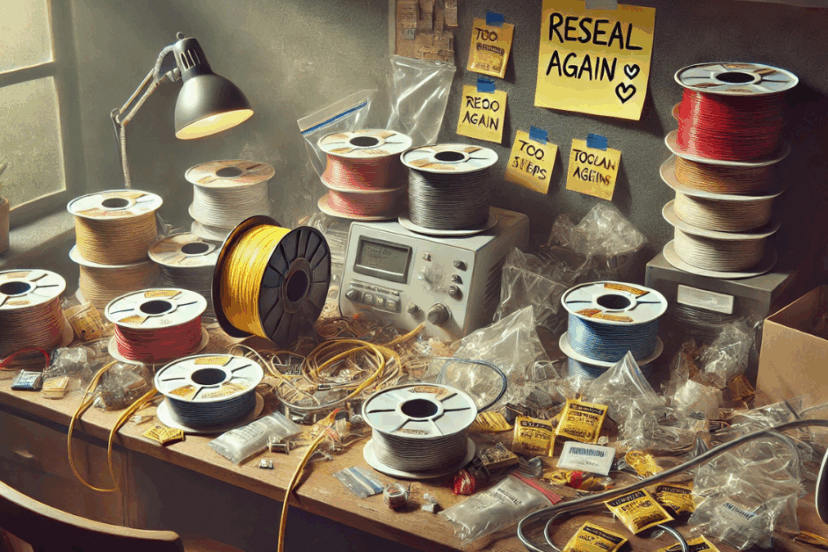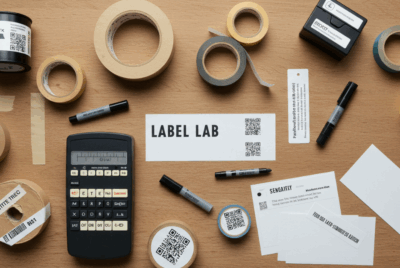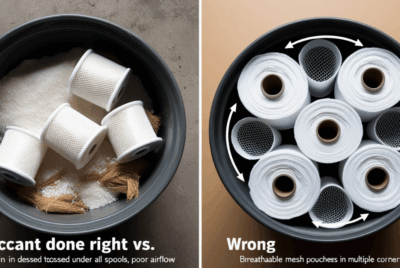What Are the Drawbacks or Limitations of Using Vacuum-Sealed Bags for Filament Storage?
While vacuum-sealed bags offer several advantages for 3D filament storage, such as moisture protection, space efficiency, and prolonged shelf life, they do have certain drawbacks and limitations. Understanding these potential challenges can help you decide whether vacuum-sealing is the best option for your filament storage needs. Below are the key limitations:
1. Requires Vacuum Sealing Equipment
- Drawback: To use vacuum-sealed bags effectively, you need a vacuum sealer and the appropriate sealing bags. This adds an extra cost and effort for the initial setup.
- Why It’s a Concern: For someone who doesn’t have a vacuum sealer, this can be an inconvenient or costly investment. Manual sealing or using alternative methods, such as airtight containers, might be easier and more affordable for some users.
- Solution: While vacuum sealers aren’t prohibitively expensive, it’s important to factor in the initial cost and the ongoing need for vacuum-sealing bags when considering this method.
2. Resealing Is Required After Every Use
- Drawback: Every time you open a vacuum-sealed bag to use filament, the bag loses its airtight seal, and you need to reseal it to keep the filament protected.
- Why It’s a Concern: Frequent resealing can be cumbersome, especially if you’re regularly switching between filament types. This added step can be time-consuming and might reduce the convenience of using vacuum-sealed bags for active, frequent printing.
- Solution: If you’re using filament for short-term projects or frequently changing filament types, dry boxes or airtight containers may be more practical, as they allow easier access without the need to reseal.
3. Limited Access for Active Use
- Drawback: Vacuum-sealing is not ideal for actively printing with filament, especially if you need to keep changing filaments. The process of opening and resealing the bags after every print can be tedious.
- Why It’s a Concern: If you’re in an active printing setup where you’re constantly switching filaments, the vacuum-sealing process could slow you down. Unlike dry boxes, which allow easy filament access, vacuum-sealed bags are more suited to long-term storage rather than immediate or ongoing use.
- Solution: Consider using vacuum-sealed bags for storage of unused filament and a dry box or filament spool holder for your active printing setup.
4. Risk of Physical Damage to Filament Spools
- Drawback: Vacuum-sealing can exert pressure on the filament spool, potentially leading to deformation or damage over time. While this may not be a major issue for some filaments, it could cause spool shape distortion or spool tangling in certain cases.
- Why It’s a Concern: Deformation or tangling can make it harder to use the filament efficiently or lead to issues with feeding the filament into the extruder. Excessive vacuum pressure may also cause brittleness or cracking in fragile filament types.
- Solution: Ensure that you don’t over-compress the filament when vacuum sealing, and try to leave some space in the bag for the spool to maintain its shape. For larger spools, consider using a larger vacuum bag to avoid excessive pressure.
5. Moisture Control Isn’t Always Perfect
- Drawback: While vacuum-sealing significantly reduces moisture exposure, it isn’t a foolproof method. Over time, desiccants inside the bag can become saturated, and the vacuum seal can degrade, allowing moisture to creep in.
- Why It’s a Concern: If the desiccant becomes saturated or the bag isn’t properly sealed, moisture can still enter and damage the filament, particularly for highly moisture-sensitive filaments like Nylon.
- Solution: To mitigate this risk, use fresh desiccant packs periodically, especially for long-term storage. You should also store vacuum-sealed bags in a dry and cool environment to prevent moisture buildup.
6. Not Suitable for Large Filament Spools
- Drawback: Vacuum-sealing may not be the best option for large filament spools (e.g., 2.5 kg or more) due to the size of the vacuum bags and the limitations of most vacuum sealers.
- Why It’s a Concern: For larger spools, vacuum-sealing may be impractical or result in difficulty sealing the bag effectively. If the spool is too large for the vacuum bag, it might not be properly sealed, reducing the effectiveness of the moisture protection.
- Solution: If you regularly store larger spools, look for larger vacuum-sealing bags or consider using large airtight containers or filament dry boxes to protect the filament without the need for vacuum sealing.
7. Difficulty in Handling with Multiple Spools
- Drawback: If you have multiple spools of filament, sealing each one individually in a vacuum bag can become cumbersome. Additionally, storing multiple sealed bags can take up more space than necessary, especially when organizing multiple filament types.
- Why It’s a Concern: If you have a large collection of filament and need to store several spools, it can be challenging to keep everything properly vacuum-sealed and organized without taking up excessive storage space.
- Solution: Use larger vacuum bags for multiple spools or consider other storage options like dry boxes or filament racks that provide easier access and organization for multiple spools.
8. Potential Cost of Ongoing Supplies
- Drawback: Regularly vacuum-sealing filament requires an ongoing supply of vacuum-sealer bags and desiccants. While the initial setup may be affordable, the cost of replacement bags and desiccants can add up over time.
- Why It’s a Concern: If you have a large filament collection and store it frequently, these costs can become significant, especially if you are using premium vacuum-sealing bags or desiccant products.
- Solution: Consider buying vacuum-sealer bags and desiccants in bulk to reduce the cost over time. Alternatively, explore other filament storage solutions with lower maintenance costs, such as airtight containers or dry boxes.
9. Risk of Compromising the Seal
- Drawback: If the vacuum-sealed bag is damaged or if the seal is compromised (e.g., from rough handling), the filament could be exposed to air and moisture, which could ruin the filament quality.
- Why It’s a Concern: Even though vacuum-sealing offers an airtight environment, accidental punctures or improper sealing can render the storage ineffective. Any tear or hole in the bag would expose the filament to the elements.
- Solution: Handle vacuum-sealed bags carefully and ensure that the sealing process is done properly. Recheck the seal before storing or using the filament, especially if the bag has been handled frequently.
Summary of Drawbacks of Vacuum-Sealed Bags for Filament Storage:
- Requires Vacuum Sealing Equipment: Initial cost and setup for a vacuum sealer.
- Resealing After Each Use: Time-consuming to reseal after opening.
- Limited Access for Active Use: Not ideal for frequent filament changes during active printing.
- Risk of Physical Damage: Vacuum pressure may deform or damage spools, especially larger ones.
- Moisture Control Isn’t Always Perfect: Desiccants can become saturated, and seals may degrade over time.
- Not Suitable for Large Spools: Large filament rolls may not fit in standard vacuum bags.
- Handling Multiple Spools: Difficult to manage and store several spools effectively.
- Ongoing Cost for Supplies: Replacement bags and desiccants can add up over time.
- Risk of Seal Compromise: Vacuum-sealed bags may be damaged or lose their seal, leading to exposure to moisture.
Conclusion
Vacuum-sealing is an excellent method for protecting filament from moisture and ensuring long-term storage, but it does come with some drawbacks. For users who primarily need to store filament long-term or in a compact, moisture-controlled environment, vacuum-sealing is an effective solution. However, if you need frequent access to filament or are working with large spools, other storage options, such as dry boxes or airtight containers, may be more convenient.




